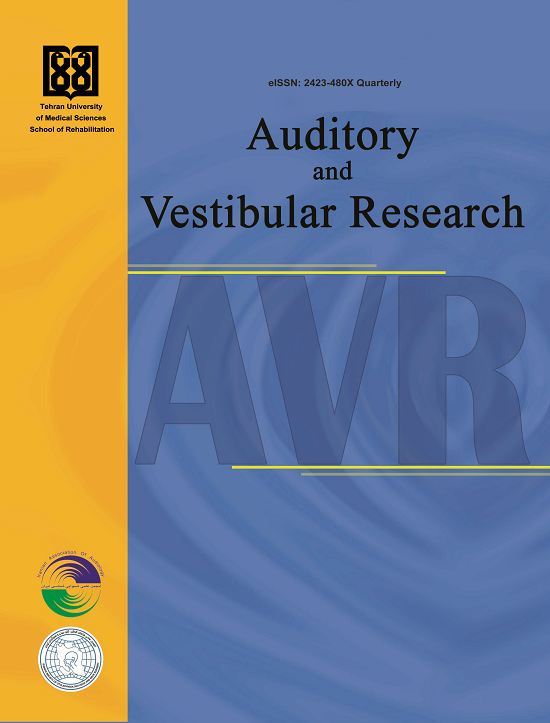Post-meningitis cochlear implantation
Abstract
Background and aim: Bacterial meningitis, mainly Streptococcus pneumonia, is a primary cause of profound bilateral sensorineural hearing loss. Post-meningitic cochlear ossification, bony cochlear lumen obliteration, and often complicates cochlear implantation (CI) are happen post meningitis. The aim of this study is to evaluate the hearing outcomes and complications of CI in patients with hearing loss due to bacterial meningitis.
Methods: A 10-year retrospective review of 45 patients (pediatric and adult) underwent CI after bacterial meningitis at Martyr Gazi Alhariri Hospital, between 2012 and 2022. The outcomes were analyzed using speech perception scores, radiological imaging findings, and surgical reports for each patient.
Results: Early implantation (≤3 months post-meningitis) correlated with higher open-set speech recognition. Ossification severity inversely predicted electrode insertion depth (r= -0.67, p<0.01). In terms of audiological outcomes, open-set speech recognition was achieved in 62.2% of the patients (28/45), and pediatric showed significantly better performance than adults (75.0% vs. 35.3%). Similarly, early CI (≤3 months post-meningitis) was associated with higher rates of open-set speech recognition than was delayed implantation (>3 months) (72.7% vs. 43.5%; p = 0.003). The mean speech intelligibility rating (SIR) score for the entire cohort was 3.4±1.2, with pediatric patients scoring significantly higher than adults (4.1±0.8 vs. 2.7±1.1, respectively; p = 0.01).
Conclusion: Early CI and computed tomography (CT) imaging are critical for achieving better outcomes in post-meningitic deafness. Anticipatory CI within 3 months of post-meningitis enhances outcomes. Advanced imaging and adaptable surgical strategies can alleviate ossification-related challenges.
2. Rodenburg-Vlot MB, Ruytjens L, Oostenbrink R, Goedegebure A, van der Schroeff MP. Systematic Review: Incidence and Course of Hearing Loss Caused by Bacterial Meningitis: In Search of an Optimal Timed Audiological Follow-up. Otol Neurotol. 2016;37(1):1-8. [DOI:10.1097/MAO.0000000000000922]
3. Kaya S, Paparella MM, Cureoglu S. Pathologic Findings of the Cochlea in Labyrinthitis Ossificans Associated with the Round Window Membrane. Otolaryngol Head Neck Surg. 2016;155(4):635-40. [DOI:10.1177/0194599816651245]
4. Kutz JW, Simon LM, Chennupati SK, Giannoni CM, Manolidis S. Clinical predictors for hearing loss in children with bacterial meningitis. Arch Otolaryngol Head Neck Surg. 2006;132(9):941-5. [DOI:10.1001/archotol.132.9.941]
5. Jahn KN, Arenberg JG. Polarity Sensitivity in Pediatric and Adult Cochlear Implant Listeners. Trends Hear. 2019;23:2331216519862987. [DOI:10.1177/2331216519862987]
6. Canzi P, Aprile F, Manfrin M, Avato I, Magnetto M, Minervini D, et al. "Emergency" Cochlear Implantation in Labyrinthitis Ossificans Secondary to Polyarteritis Nodosa: How to Face a Rare Entity. J Int Adv Otol. 2019;15(1):156-9. [DOI:10.5152/iao.2018.5463]
7. Vaid S, Vaid N, Manikoth M, Zope A. Role of HRCT and MRI of the Temporal Bone in Predicting and Grading the Degree of Difficulty of Cochlear Implant Surgery. Indian J Otolaryngol Head Neck Surg. 2015;67(2):150-8. [DOI:10.1007/s12070-015-0858-z]
8. Lenarz T, Lesinski-Schiedat A, Weber BP, Issing PR, Frohne C, Büchner A, et al. The nucleus double array cochlear implant: a new concept for the obliterated cochlea. Otol Neurotol. 2001;22(1):24-32. [DOI:10.1097/00129492-200101000-00006]
9. Entwisle LK, Warren SE, Messersmith JJ. Cochlear Implantation for Children and Adults with Severe-to-Profound Hearing Loss. Semin Hear. 2018;39(4):390-404. [DOI:10.1055/s-0038-1670705]
10. Rubinstein JT, Bierer S, Kaneko C, Ling L, Nie K, Oxford T, et al. Implantation of the semicircular canals with preservation of hearing and rotational sensitivity: a vestibular neurostimulator suitable for clinical research. Otol Neurotol. 2012;33(5):789-96. [DOI:10.1097/MAO.0b013e318254ec24]
11. Vashishth A, Fulcheri A, Prasad SC, Bassi M, Rossi G, Caruso A, et al. Cochlear Implantation in Cochlear Ossification: Retrospective Review of Etiologies, Surgical Considerations, and Auditory Outcomes. Otol Neurotol. 2018;39(1):17-28. [DOI:10.1097/MAO.0000000000001613]
12. Deshpande N, Aminpour N, Cheng H, Johns JD, Hoa M. Cochlear Implantation and Perioperative Management in Autoimmune Inner Ear Disease: A Systematic Review and Meta-Analysis. Otol Neurotol Open. 2021;1(2):e006. [DOI:10.1097/ONO.0000000000000006]
13. Singhal K, Singhal J, Muzaffar J, Monksfield P, Bance M. Outcomes of Cochlear Implantation in Patients with Post-Meningitis Deafness: A Systematic Review and Narrative Synthesis. J Int Adv Otol. 2020;16(3):395-410. [DOI:10.5152/iao.2020.9040]
| Files | ||
| Issue | Articles in Press | |
| Section | Research Article(s) | |
| Keywords | ||
| Bacterial meningitis cochlear implantation drill-out procedure partial electrode insertion | ||
| Rights and permissions | |

|
This work is licensed under a Creative Commons Attribution-NonCommercial 4.0 International License. |






